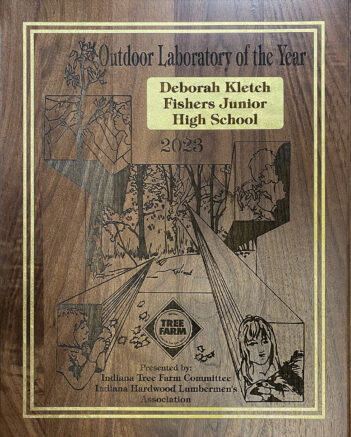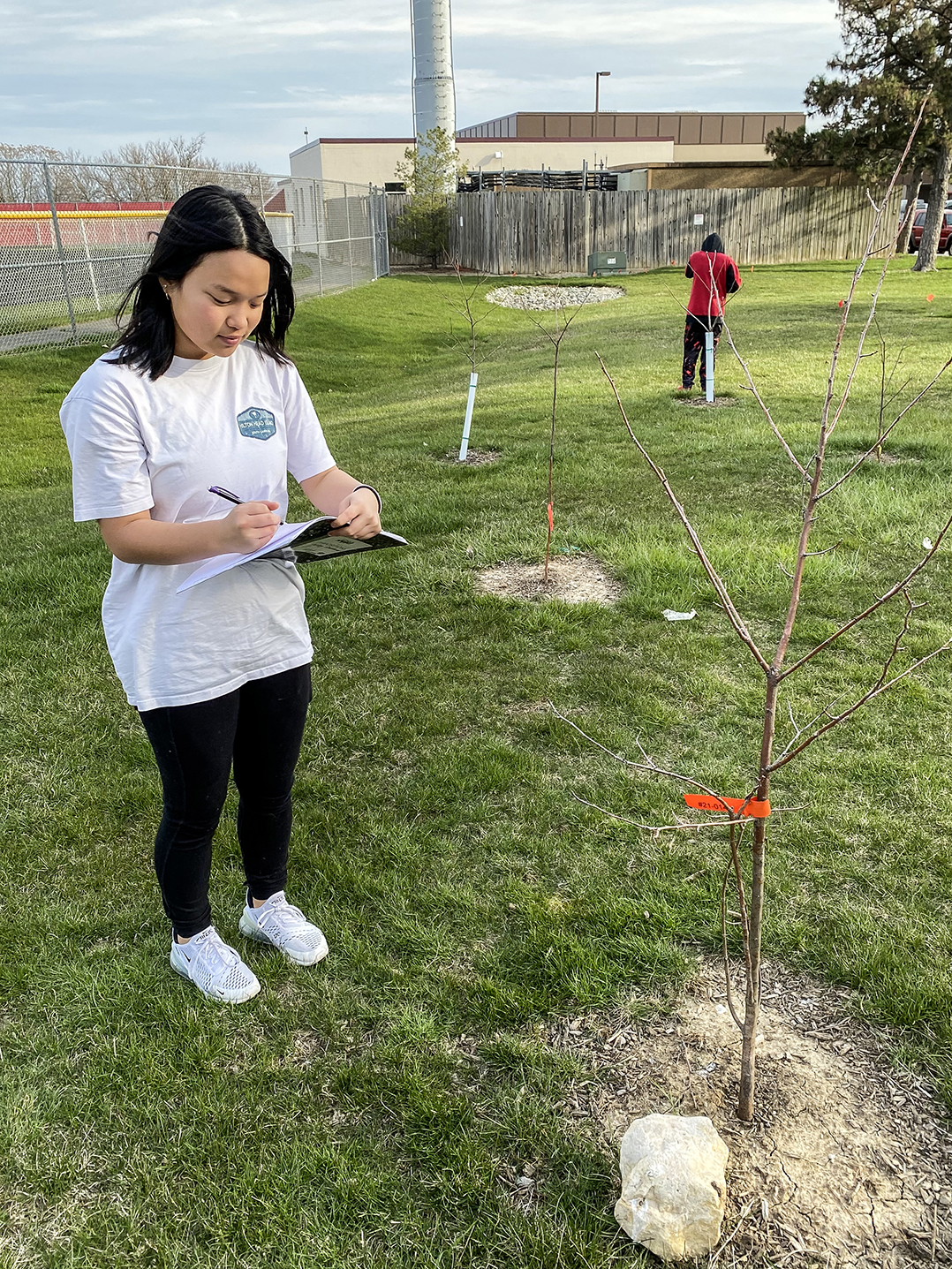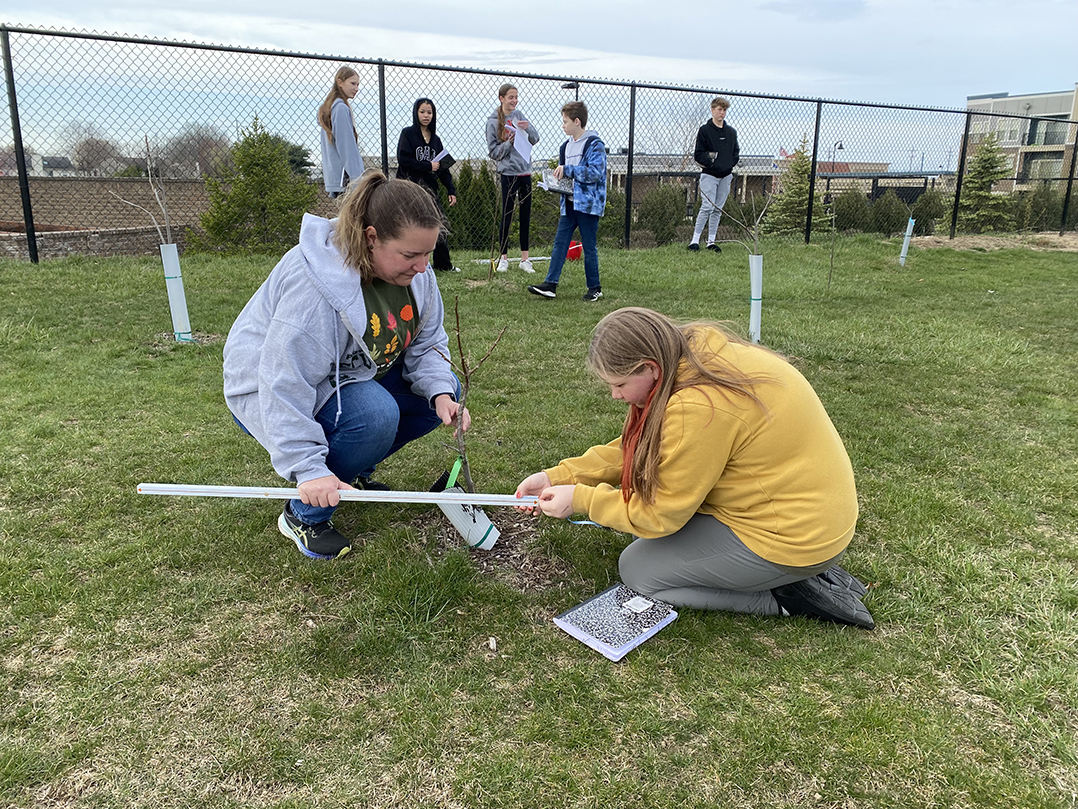Seventh-graders at Fishers Junior High School are an integral part of an award-winning research program, with the long-term goal of saving native trees that are functionally extinct due to an invasive fungus.
The program, led by science teacher Deborah Kletch, has been ongoing for several years. Kletch said the young trees are hybrids, combining endangered American chestnut and beechnut trees with Asian varieties that are more resistant to the fungus, commonly called Asian blight. The fungus first was introduced to Europe and North America in the early 1900s.

“It kills off everything above the roots, but then the (trees) come back,” Kletch said. “But every time it comes back, it’s more like a bush. So, we’re actually losing ‘chestnuts roasting on an open fire.’”
She said Fishers Junior High was one of five schools — and the only junior high — picked to participate in the statewide project. To qualify, Kletch was trained through the Indiana Department of Natural Resources forestry program, spending a week in southern Indiana.
After they were approved to be part of the project in 2020, they had to wait until 2021 to get the trees into the ground. So, the small orchard has been in place for about three years.
“We have an arborist who comes out to work with us and a DNR person who comes out and works with us,” she said. “We’ve only lost five trees — they originally thought we would lose 50 percent in the first year.”
She noted that the five lost trees were taken out over time by lawnmowers, not the invasive fungus.
Kletch said her students’ role is to maintain data about the trees.
“They are monitoring growth — both height and diameter of the trunk. They are monitoring health, bug activity, leaf health and looking for the fungus,” she said. “Every month, we go out and look for these things. The first month, they’re not great at being accurate. But by the end, they are much better.”
Kletch hopes the kids learn that anyone can contribute to science in a meaningful way.
“That you don’t have to necessarily have a degree to contribute, that anybody can help,” she said. “And that maybe we can save something that we didn’t know was even (endangered) — they always think of endangered species as animals, the cute fuzzy ones. But we lose a lot of species every year, including plants.”
The students enjoy their tree time, she said, at least in part because they get to go outside. Each student is assigned their own tree, which makes it personal.
“They actually really get attached to their trees,” she said. “We had a tree last year that got hit by a lawnmower and the girl cried.”
The trees are planted in a green space next to the football field directly behind the school. When it’s time for their monthly checkups, students take a five-minute walk to their designated tree and start logging observations, including sketches.
Vincent Kitchen said he’s learned about how tree growth varies based on the season. He said his tree has some new growth this month and pointed to a thin branch that hadn’t been there before. He also pointed out numerous buds — proof that spring is, indeed, fast approaching.
Hadley Ealy was busily writing down her observations, including the few fall leaves still clinging to the branches of her tree and the numerous buds that appeared since the previous month.
“And then I’m writing down the differences I noticed from my observations,” she said. “Then I’ll look at the insect activity and, like, the color of all the leaves and branches. And then at the very end of the year, we’ll write down a big summary.”
Because young trees don’t stop needing care during the summer months when school is out, Kletch and some volunteers come to the small orchard a couple times a week in summer to check on them and make sure they get enough water while they establish themselves. Kletch believes that extra care is part of why they have lost so few trees compared to other research sites.
“We ran 18 hoses from the building to get out to where the trees are,” she said. “It takes eight minutes just for the water to transport” and about two hours to get all the trees watered.
Another potential reason for the trees’ success is the fence surrounding the site.
“Deer carry the fungus on their fur,” she said. “And because we are a fenced-in school area, the deer don’t come over anymore.”
Kletch, her STARS — Super Talented Achieving Respecting Students — and Fishers Junior High School recently were recognized for the research program with the Outdoor Laboratory of the Year award from the Indiana Tree Farm Committee and Indiana Hardwood Lumbermen’s Association.

A community effort
The Fishers Junior High School research trees project has had a lot of partners helping with its success. Seventh-grade science teacher Deborah Kletch said they had assistance from the City of Fishers, which dug the holes for all the trees; along with other groups that helped with irrigation, fundraising and building benches.
A tech-ed class is designing a roof to shelter the project’s sign, she said, and they’ll add some birdhouses to encourage birds to congregate closer to the trees.
“My students are designing the birdhouses,” Kletch said. “They’ve been doing research about what kind of birds we have, what they would need and things like that.”





